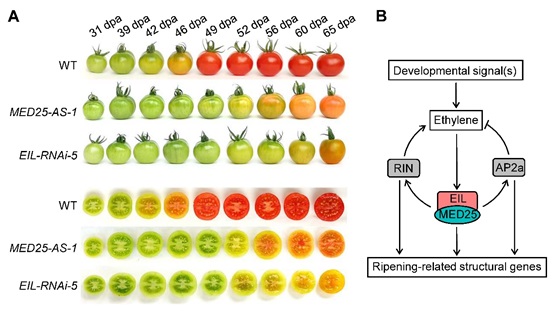Chinese Academy of Sciences
Fleshy fruits are an important part of the human diet. They provide vitamins, carotenoids, flavonoids and other health-promoting nutrients. Because most of the fruit nutritional and sensory quality traits are determined at the ripening stage, elucidating the molecular mechanism of fruit ripening has guiding significance for improving fruit quality.
Prof. Dr. LI Chuanyou's group at the Institute of Genetics and Developmental Biology (IGDB) of the Chinese Academy of Sciences (CAS) has revealed the mechanistic function of MED25, a Mediator subunit, in regulating fruit ripening.
Fruit ripening is a complex and highly coordinated process which relies on the concerted expression of numerous ripening-related genes, and eventually results in extensive changes in fruit color, texture, aroma, flavor and other quality attributes. Therefore, in a sense, fruit ripening is a well-orchestrated transcriptional reprogramming.
Based on the respiratory and ethylene production patterns during ripening, fruits can be classified into two classes: climacteric fruit and non-climacteric fruit. In tomato (Solanum lycopersicum), a model climacteric fruit, ethylene is believed to be a key signal that regulates fruit ripening. Silencing of EIN3/EIN3-LIKE 1-4 (EIL1-4), which act as master regulators of the ethylene pathway, leads to a severe non-ripening phenotype in tomato.
In addition to ETHYLENE-INSENSITIVE 3 (EIN3)/EIN3-LIKE (EIL), a plethora of ripening-related transcription factors have been identified in tomato, including RIPENING INHIBITOR (RIN), NON-RIPENING (NOR), COLORLESS NON-RIPENING (CNR), and FRUITFULL 1 (FUL1). It is not clear the relationship between these transcription factors and how they relay regulatory signals to the RNA polymerase II (Pol II) general transcription machinery to guide the latter to transcribe ripening-related genes.
In this study, Prof. LI's group revealed that MED25 physically interacts with EIL transcription factors, thereby relaying the ethylene signal to the Pol II machinery to control ripening-related gene expression.
They found that MED25 knockdown results in ripening-related defects similar to those observed in EIL-RNAi fruits. A series of biochemical experiments demonstrated that MED25 interacts with EIL.
RNA-seq analysis revealed that EIL and MED25 co-regulate more than 5,000 ripening-associated genes and confer similar effects on their expression. These results indicate that MED25 forms a transcriptional complex with EIL proteins to regulate the expression of ripening-related genes.
They then demonstrated that the EIL1-MED25 module regulate the expression of ripening-related regulatory as well as structural genes through promoter binding. On the one hand, it directly regulates the expression of some structural genes. On the other hand, it forms hierarchical transcriptional cascades together with its downstream transcriptional regulators (such as RIN, NOR, CNR and FUL1) to regulate the expression of some structural genes.
They also demonstrated that the EIL1-MED25 module forms both positive and negative feedback loops with its downstream regulators to maintain ethylene homeostasis during ripening.
These findings advance our understanding of ripening regulation and have implications for improving fruit quality in the future.
This work entitled "Tomato MED25 regulates fruit ripening by interacting with EIN3-like transcription factors" was published in The Plant Cell on December 6.
This study was funded by the National Key R&D Program of China and the National Natural Science Foundation of China.

MED25 interacts with EIL to regulating fruit ripening. (Image by IGDB)
/Public Release. This material from the originating organization/author(s) might be of the point-in-time nature, and edited for clarity, style and length. Mirage.News does not take institutional positions or sides, and all views, positions, and conclusions expressed herein are solely those of the author(s).View in full here.






